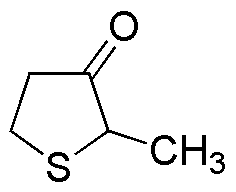2-Methyltetrahydrothiophen-3-one is widely utilized in research focused on:
- Fragrance Industry: This compound is valued for its unique odor profile, making it a popular choice in the formulation of perfumes and scented products.
- Flavoring Agents: It is used in the food industry as a flavor enhancer, particularly in savory products, providing a distinct taste that can elevate culinary experiences.
- Pharmaceuticals: Researchers explore its potential in drug development, particularly in creating compounds with specific therapeutic effects, thanks to its unique chemical structure.
- Agricultural Applications: The compound can be investigated for use in developing eco-friendly pesticides or fungicides, contributing to sustainable agriculture practices.
- Cosmetic Formulations: Its properties make it suitable for incorporation into cosmetic products, enhancing scent and providing a pleasant sensory experience for users.
General Information
Properties
Safety and Regulations
Applications
2-Methyltetrahydrothiophen-3-one is widely utilized in research focused on:
- Fragrance Industry: This compound is valued for its unique odor profile, making it a popular choice in the formulation of perfumes and scented products.
- Flavoring Agents: It is used in the food industry as a flavor enhancer, particularly in savory products, providing a distinct taste that can elevate culinary experiences.
- Pharmaceuticals: Researchers explore its potential in drug development, particularly in creating compounds with specific therapeutic effects, thanks to its unique chemical structure.
- Agricultural Applications: The compound can be investigated for use in developing eco-friendly pesticides or fungicides, contributing to sustainable agriculture practices.
- Cosmetic Formulations: Its properties make it suitable for incorporation into cosmetic products, enhancing scent and providing a pleasant sensory experience for users.
Documents
Safety Data Sheets (SDS)
The SDS provides comprehensive safety information on handling, storage, and disposal of the product.
Product Specification (PS)
The PS provides a comprehensive breakdown of the product’s properties, including chemical composition, physical state, purity, and storage requirements. It also details acceptable quality ranges and the product's intended applications.
Certificates of Analysis (COA)
Search for Certificates of Analysis (COA) by entering the products Lot Number. Lot and Batch Numbers can be found on a product’s label following the words ‘Lot’ or ‘Batch’.
*Catalog Number
*Lot Number
Certificates Of Origin (COO)
This COO confirms the country where the product was manufactured, and also details the materials and components used in it and whether it is derived from natural, synthetic, or other specific sources. This certificate may be required for customs, trade, and regulatory compliance.
*Catalog Number
*Lot Number
Safety Data Sheets (SDS)
The SDS provides comprehensive safety information on handling, storage, and disposal of the product.
DownloadProduct Specification (PS)
The PS provides a comprehensive breakdown of the product’s properties, including chemical composition, physical state, purity, and storage requirements. It also details acceptable quality ranges and the product's intended applications.
DownloadCertificates of Analysis (COA)
Search for Certificates of Analysis (COA) by entering the products Lot Number. Lot and Batch Numbers can be found on a product’s label following the words ‘Lot’ or ‘Batch’.
*Catalog Number
*Lot Number
Certificates Of Origin (COO)
This COO confirms the country where the product was manufactured, and also details the materials and components used in it and whether it is derived from natural, synthetic, or other specific sources. This certificate may be required for customs, trade, and regulatory compliance.


